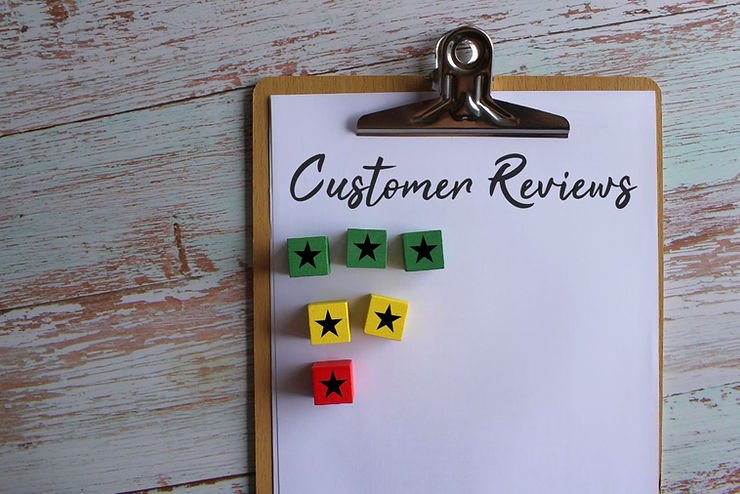By encouraging product customers to leave reviews, responding to reviews, using reviews to improve products, showcasing reviews on your website, and using reviews in your marketing, you can boost sales on your e-commerce site. Product reviews are an important source of information for potential customers who are considering purchasing.
A product review is a written or spoken evaluation of a product, usually by a customer who has purchased and used the product. Product reviews provide feedback on the product’s features, performance, and overall value, and can be positive, negative, or neutral in tone. Product reviews are typically found on e-commerce websites, but can also be found on social media, review sites, and blogs. They also provide social proof and can help customers make more informed purchasing decisions.
Product Reviews Highlights in E-commerce
Product reviews will build trust with potential customers, improve search engine rankings, and increase sales. Here are some ways in which product reviews can have a significant impact on your e-commerce site:
Social Proof
Product reviews provide social proof that your products are valuable and of high quality. When potential customers see positive reviews from other customers, they are more likely to trust your brand and make a purchase.
Trust Building
By encouraging customers to leave reviews and responding to their feedback, you can build trust with your customers. This can help improve customer loyalty and drive repeat business.
SEO Benefits
Including user-generated content such as product reviews on your website can improve your search engine rankings. Search engines tend to favor fresh, relevant content, and product reviews can provide this type of content for your website.
Improved Product Development
By listening to customer feedback in reviews, you can gain insights into what your customers like and dislike about your products. This information can be used to make improvements to your products, which can help increase customer satisfaction and drive sales.
Showcasing positive reviews on your product pages and throughout your site can help persuade potential customers to make a purchase. This is because reviews provide evidence that your products are valuable and of high quality, which can help overcome any doubts or objections that potential customers may have. E-commerce businesses can build trust with potential customers, improve search engine rankings, and increase sales. By encouraging customers to leave reviews, responding to their feedback, and using reviews to improve your products, you can build a loyal customer base and drive business growth.
Encouraging Customers to Leave Reviews: How to Ask for and Incentivize Reviews

Product reviews are an essential part of any e-commerce business. They provide valuable feedback on your products, help build trust with potential customers, and can improve your search engine rankings. However, getting customers to leave reviews can be challenging. Here are some effective ways that will encourage customers to leave reviews on your e-commerce site:
Make It Easy to Leave a Review
The first step to getting customers to leave reviews is to make it easy for them to do so. If your review process is too complicated, customers may not bother leaving a review at all. Ensure that your review process is straightforward and intuitive. Make sure customers can easily find the review section on your product pages, and that leaving a review doesn’t require too many steps.
Send Follow-up Emails
One of the most effective ways to encourage customers to leave reviews is to send follow-up emails after they have received their orders. These emails can include a call-to-action asking customers to leave a review, along with a link to the review section on your product pages. You can also include a discount code or other incentives to encourage customers to leave a review.
Offer Incentives
Incentivizing customers to leave reviews can be a powerful way to encourage them to do so. Some e-commerce businesses offer a discount code or other incentives in exchange for leaving a review. For example, you could offer a 10% discount on their next purchase for leaving a review. Just be sure to follow the guidelines of the platform you’re using (e.g. Amazon, Yelp, etc.) as some prohibit incentivizing reviews.
Use Social Media
Social media can be a great way to encourage customers to leave reviews. Share positive reviews on your social media pages and ask your followers to leave their reviews. You can also run a social media contest or giveaway that requires leaving a review to enter.
Make It Personal
Personalization can be a powerful tool for encouraging customers to leave reviews. Try sending personalized emails to customers asking them to leave a review. Use their name and reference the product they purchased. This shows that you value their feedback and are interested in their opinions.
Ask At The Right Time
Timing is key when it comes to asking customers to leave a review. You don’t want to ask too soon before the customer has had a chance to use the product, but you also don’t want to wait too long, when the customer may have forgotten about the purchase. Try asking for a review a few weeks after the customer has received their order.
Respond to Reviews
Responding to reviews is important for several reasons. First, it shows that you are engaged with your customers and value their feedback. Second, it encourages more customers to leave reviews, knowing that their feedback will be seen and appreciated. Finally, responding to negative reviews can help turn a negative experience into a positive one. When you respond to negative reviews and offer solutions or apologies, you show that you care about your customers and are willing to address any concerns they may have.
Provide Great Customer Service
Providing great customer service is essential for encouraging customers to leave reviews. When customers have a positive experience with your business, they are more likely to leave a positive review. This means being responsive to customer inquiries, providing fast and reliable shipping, and ensuring that your products are of high quality.
Make It Fun
Encouraging customers to leave reviews doesn’t have to be boring. Try making it fun by incorporating gamification elements into your review process. For example, you could award badges or points for leaving reviews, or create a leaderboard of top reviewers. This can encourage friendly competition among your customers and make leaving reviews more enjoyable.
Show Appreciation
Showing appreciation for customers who take the time to leave reviews. You can do this by responding to their reviews, thanking them for their feedback, and highlighting their reviews on your website or social media pages. This shows that you value their opinions and are grateful for their support.

Encouraging customers to leave reviews is essential for any e-commerce business. By making it easy to leave a review, sending follow-up emails, offering incentives, using social media, personalizing your requests, timing your requests appropriately, responding to reviews, providing great customer service, making it fun, and showing appreciation, you can encourage more customers to leave reviews and improve your business’s reputation and sales.
Responding to Reviews: The Importance of Engaging with Your Customers and Addressing Their Feedback
They provide feedback on your products, help build trust with potential customers, and can improve your search engine rankings. However, responding to reviews is just as important as encouraging customers to leave them
Why Responding to Reviews is Important
Responding to reviews is essential for several reasons. First, it shows that you are engaged with your customers and value their feedback. This can help build trust with potential customers and improve customer loyalty. Second, responding to reviews can help address any concerns or issues that customers may have with your products. This can help improve customer satisfaction and prevent negative reviews from turning away potential customers. As a result, responding to reviews can help improve your search engine rankings. Search engines tend to favor websites that have fresh, relevant content, and responding to reviews can help provide this content.
-
Thank the customer for their review
-
Highlight specific positive aspects of the review, such as the customer’s favorite feature of the product
-
Reinforce the positive experience by telling the customer that you’re glad they enjoyed the product
-
Encourage the customer to make additional purchases in the future
How to Respond to Negative Reviews

Responding to negative reviews can be more challenging, but it’s essential for addressing customer concerns and preventing potential customers from being turned away by negative feedback. When responding to negative reviews, here are some tips to keep in mind:
-
Apologize for any negative experience that the customer had
-
Offer a solution or explanation for the issue that the customer raised
-
Provide a contact email or phone number for the customer to reach out to you directly
-
Ask the customer to provide additional feedback or information if necessary.
Here’s an example response to a negative review: “We’re sorry to hear that you had a negative experience with our product. We take all feedback seriously and would like to make things right. Please reach out to us directly at [contact email or phone number] so that we can address the issue and ensure that you’re satisfied with your purchase. Thank you for bringing this to our attention.”
How to Respond to Neutral Reviews
Neutral reviews may not require as much of a response as positive or negative reviews, but it’s still important to acknowledge the customer’s feedback and thank them for taking the time to leave a review. Here are some tips for responding to neutral reviews:
-
-
Thank the customer for their feedback.
-
Acknowledge any specific concerns or issues that the customer raised.
-
Provide additional information or context if necessary.
-
Encourage the customer to make additional purchases in the future.
-
Here’s an example response to a neutral review:
“Thank you for taking the time to leave a review. We appreciate all feedback, whether it’s positive or negative. We’re sorry to hear that you had some concerns with our product, and we’d be happy to provide additional information or assistance if necessary. Please don’t hesitate to reach out to us directly if you have any questions or concerns. We hope that you’ll consider giving us another chance in the future!”
Responding to reviews is an essential part of managing your e-commerce business. Whether the reviews are positive, negative, or neutral, it’s important to engage with your customers and address their feedback in a timely and professional manner. By responding to reviews, you can build trust with potential customers, improve customer loyalty, and prevent negative reviews from turning away potential business. So, be sure to monitor your reviews regularly, respond to them promptly and professionally, and use the feedback to improve your products and services.
Using Reviews to Improve Your Products
Product reviews are a valuable source of feedback for e-commerce businesses. They provide insights into what customers like and dislike about your products, and can help you identify areas for improvement. In this article, we’ll discuss how to use reviews to improve your products, and how to make changes based on customer feedback.
How to Listen to Customer Feedback
The first step to using reviews to improve your products is to monitor your reviews regularly. This means checking your reviews regularly and paying close attention to the feedback that customers are providing. Make a note of any recurring issues or complaints that customers are mentioning, as these may be areas that require attention.
Once you have collected a significant number of reviews, it’s time to analyze the feedback. Look for patterns in the feedback and try to identify any common themes or issues that customers are mentioning. Are customers consistently mentioning issues with the sizing of your products? Are they experiencing difficulties with the checkout process on your website? Identifying these issues can help you prioritize the changes that need to be made.
Make Improvements Based on Reviews
Based on the feedback that you have received, it’s time to make changes to your products or website. This can include making changes to your product descriptions, adjusting your sizing charts, or making changes to your website’s layout or checkout process. When making changes, it’s important to keep your customers in mind and make changes that will benefit them. Once you have made changes, it’s important to test them to ensure that they are effective. This can involve testing the changes on a small scale before implementing them across your entire product line or website. For example, if you have made changes to your sizing charts, you may want to test them on a few products before making the changes across your entire product line.
After making changes, it’s important to continue soliciting feedback from your customers. This can involve asking customers to leave reviews after making a purchase or sending follow-up emails to customers who have left reviews in the past. By continuing to gather feedback, you can ensure that your products and website are always improving and meeting the needs of your customers. Using reviews to improve your products is an important part of managing your e-commerce business. By monitoring your reviews, analyzing the feedback, making changes, testing the changes, and soliciting additional feedback, you can ensure that your products and website are meeting the needs of your customers. So, be sure to listen to your customers, make changes based on their feedback, and continue to gather feedback to ensure that your products and website are always improving.
Showcasing Reviews on Your Website

Product reviews are an essential part of any e-commerce business. They provide valuable feedback on your products, help build trust with potential customers, and can improve your search engine rankings. However, it’s not enough to simply encourage customers to leave reviews. You also need to showcase those reviews on your website. In this article, we’ll discuss the benefits of showcasing reviews on your website, and how to do it effectively.
Build Trust with Potential Customers
One of the biggest benefits of showcasing reviews on your website is that it can help build trust with potential customers. When customers are considering purchasing a product, they want to know that other customers have had positive experiences with that product. By showcasing reviews prominently on your product pages, you can provide social proof and help potential customers feel more confident in their purchasing decisions.
Improve Search Engine Rankings
Another benefit of showcasing reviews on your website is that it can improve your search engine rankings. Search engines like Google favor websites that have fresh, relevant content, and showcasing reviews can help provide this content. This can help improve your website’s visibility in search results and drive more traffic to your site.
Increase Conversions
Showcasing reviews on your website can also help increase conversions. When customers see positive reviews on your product pages, they are more likely to make a purchase. This is because positive reviews can help overcome any doubts or objections that customers may have about your products. By showcasing reviews prominently, you can increase the likelihood that customers will make a purchase.
Use Visual Elements
When showcasing reviews on your website, it’s important to use visual elements to make them stand out. This can include using bold text or different font colors to draw attention to the reviews. You can also use images or graphics to highlight key quotes from positive reviews.
Organize Reviews Effectively
Another important aspect of showcasing reviews on your website is to organize them effectively. This can involve grouping reviews by product category or using tags to help customers find reviews that are relevant to their needs. You can also use a star rating system to make it easy for customers to quickly see the overall rating for a product.
Use Reviews in Other Marketing Materials
In addition to showcasing reviews on your website, you can also use reviews in other marketing materials. This can include using positive reviews in email newsletters or social media posts or featuring customer testimonials on your homepage or landing pages. By leveraging positive reviews across all of your marketing channels, you can maximize their impact and reach a wider audience.

It’s important to respond to reviews, both positive and negative. When you respond to reviews, you show that you are engaged with your customers and value their feedback. This can help build trust with potential customers and improve customer loyalty. Responding to negative reviews can also help turn a negative experience into a positive one by addressing any concerns that the customer may have raised. Showcasing reviews on your website is an essential part of managing your e-commerce business. By building trust with potential customers, improving search engine rankings, increasing conversions, using visual elements, organizing reviews effectively, using reviews in other marketing materials, and responding to reviews, you can maximize the impact of customer feedback and improve your business’s reputation and sales. So, be sure to showcase your reviews prominently on your website and across all of your marketing channels to reap the benefits of customer feedback.
Using Reviews in Your Marketing
Product reviews are a valuable source of feedback for e-commerce businesses. They provide insights into what customers like and dislike about your products, and can help you identify areas for improvement. However, reviews can also be used as a powerful marketing tool. In this article, we’ll discuss how to use reviews in your marketing, and how to leverage customer feedback to drive sales and improve your business’s reputation.
One way to use reviews in your marketing is to incorporate them into your advertising. This can involve using quotes from positive reviews in your ad copy or showcasing customer ratings in your ads. By incorporating reviews into your advertising, you can provide social proof and help potential customers feel more confident in their purchasing decisions. In addition, how you can use reviews in your marketing is to include them in your email campaigns. This can involve featuring customer testimonials in your email newsletters or sending personalized follow-up emails to customers who have left reviews in the past. By using reviews in your email marketing, you can help build trust with your subscribers and encourage them to make a purchase.
How to Leverage Customer Feedback

Social media is another great platform for showcasing reviews. You can share positive reviews on your social media pages and use them to promote your products. This can help increase engagement with your followers and encourage them to share their own experiences with your products. One of the biggest benefits of using reviews in your marketing is that they can help create social proof. Social proof is the idea that people are more likely to purchase if they see that others have had positive experiences with your products. By showcasing positive reviews on your website, social media pages, and advertising, you can create social proof and encourage potential customers to make a purchase.
While positive reviews are great for promoting your products, negative reviews can also be useful in your marketing efforts. By addressing negative feedback and showing how you have addressed any concerns or issues, you can demonstrate your commitment to customer satisfaction and build trust with potential customers. Negative reviews can also provide valuable feedback on areas that may need improvement, which can help you make changes to your products and improve customer satisfaction.
Utilizing Review Platforms and Aggregators
One effective way to increase the visibility of your product reviews is by utilizing review platforms and aggregators. Several websites and apps aggregate product reviews from multiple sources, such as Yelp, Google My Business, and Trustpilot. By claiming your business on these platforms and actively managing your reviews, you can increase the visibility of your reviews and improve your online reputation. Utilizing review platforms and aggregators, leveraging customer-generated content, and offering incentives for reviews are all effective strategies for e-commerce businesses looking to boost sales and improve their online reputation. By incorporating these strategies into your marketing plan, you can create a comprehensive feedback loop that will help you improve your products and customer experience.
It’s important to remember that customer feedback is an ongoing process and that reviews and CGC can help you identify areas for improvement and make changes to your products and marketing efforts. By listening to your customers and actively engaging with them, you can build a loyal customer base that will help your business thrive. There are several other ways to use customer feedback to your advantage. For example, you can use reviews and customer feedback to inform your product development process, identify new market opportunities, and improve your overall customer experience. By taking a proactive approach to customer feedback, you can create a business that is customer-centric and focused on providing the best possible experience to your customers.
Utilizing review platforms and aggregators, leveraging customer-generated content, and offering incentives for reviews are just a few of the many ways that e-commerce businesses can use customer feedback to their advantage. By actively engaging with your customers and using their feedback to improve your products and marketing efforts, you can build a loyal customer base that will help your business thrive. So, be sure to listen to your customers, use their feedback to improve your business, and leverage positive reviews and CGC to drive sales and grow your business.
Leveraging Customer-Generated Content

How to Boost Sales on Your E-Commerce Site
Customer-generated content (CGC) includes user-generated content such as photos, videos, and social media posts featuring your products. By leveraging CGC, you can showcase real-life examples of your products being used and enjoyed by real customers, which can help build trust and credibility with potential customers. One of the most effective ways to encourage customers to share CGC is by creating a social media hashtag for customers to use when sharing photos of your products. This can help you easily track and collect customer content that can be used in your marketing efforts.
To create a social media hashtag, choose a short and memorable phrase or keyword that relates to your brand or product. Be sure to promote the hashtag on your website, social media channels, and in your marketing materials, and encourage customers to use the hashtag when sharing photos of your products. You can also feature customer photos on your website. This can help provide social proof and showcase real-life examples of your products being used and enjoyed by real customers. To feature customer photos on your website, consider creating a dedicated customer gallery or incorporating customer photos into your product pages. Be sure to obtain permission from customers before featuring their photos on your website, and consider offering incentives or rewards for customers who allow you to use their photos in your marketing efforts.
Another effective way to encourage customers to share CGC is by running a CGC contest or promotion. This can help incentivize customers to share photos of your products and can provide a fun and engaging way to build brand awareness and drive sales. To run a CGC contest or promotion, consider offering prizes or rewards for customers who share the best photos of your products using your social media hashtag. Be sure to promote the contest or promotion on your website, social media channels, and in your marketing materials, and be sure to comply with any relevant laws or regulations governing contests and promotions.

When using CGC on your website and social media channels, you can also incorporate CGC into your email marketing efforts. This can help personalize your emails and provide social proof that can help drive sales. To use CGC in your email marketing, consider including customer photos in your email campaigns or incorporating customer quotes or testimonials. Be sure to obtain permission from customers before using their content in your email marketing efforts, and consider segmenting your email list to ensure that you are sending relevant and targeted messages to your customers.
Showcase CGC in Your Ads
You can also leverage CGC in your advertising efforts. By featuring customer photos or testimonials in your ads, you can provide social proof and build trust with potential customers. To showcase CGC in your ads, consider creating display ads featuring customer photos or using customer quotes or testimonials in your ad copy. Be sure to comply with any relevant laws or regulations governing advertising, and consider targeting your ads to specific customer segments to ensure that you are reaching the right audience. Leveraging customer-generated content can be a powerful way to boost sales on your e-commerce site. By creating a social media hashtag, featuring customer photos on your website, running a CGC contest or promotion, using CGC in your email marketing, and showcasing CGC in your ads, you can provide social proof, build trust with potential customers, and drive sales.
So, be sure to encourage your customers to share photos of your products, incorporate CGC into your marketing efforts, and leverage the power of social proof to create a compelling-commerce marketing strategy. It’s important to remember that customer-generated content should always be used with the customer’s permission and in compliance with any relevant laws or regulations. Additionally, businesses should be proactive in monitoring and moderating customer-generated content to ensure that it aligns with their brand values and messaging. E-commerce businesses should also be aware of the potential challenges associated with leveraging customer-generated content. For example, businesses should be prepared to respond to negative feedback or criticism that may arise from customer-generated content. Additionally, businesses should avoid using customer-generated content that may be offensive or inappropriate. Leveraging customer-generated content can be a powerful way to boost sales on your e-commerce site. By creating a social media hashtag, featuring customer photos on your website, running a CGC contest or promotion, using CGC in your email marketing, and showcasing CGC in your ads, you can provide social proof, build trust with potential customers, and drive sales.
However, it’s important to use customer-generated content responsibly and in compliance with any relevant laws or regulations and to be prepared to respond to any negative feedback or criticism that may arise. By incorporating customer-generated content into your overall marketing strategy, you can create a compelling-commerce experience that will help your business thrive.
Offering Incentives for Reviews
Reviews provide social proof that can help build trust and credibility with potential customers and can also provide valuable feedback that can help improve your products and customer experience. However, getting customers to leave reviews can be challenging. Offering incentives for reviews can be an effective way to encourage customers to leave feedback and boost sales on your e-commerce site.
Offer A Discount or Coupon Code
One of the most effective incentives for reviews is to offer customers a discount or coupon code in exchange for leaving a review. This can help incentivize customers to leave feedback and can also encourage repeat business. To offer a discount or coupon code, consider creating a follow-up email or message that is sent to customers after they have made a purchase. In the email, offer customers a discount or coupon code in exchange for leaving a review. Be sure to include clear instructions on how to leave a review, and make the process as easy as possible.

Run A Review Contest or Promotion
Another effective way to incentivize customers to leave reviews is by running a review contest or promotion. This can help create a sense of urgency and excitement around leaving a review, and can also help generate buzz and engagement on your e-commerce site. To run a review contest or promotion, consider offering prizes or rewards for customers who leave the most helpful or creative reviews. Be sure to promote the contest or promotion on your website, social media channels, and in your marketing materials, and be sure to comply with any relevant laws or regulations governing contests and promotions.
Provide Early Access or Exclusive Content
You can also offer customers early access or exclusive content in exchange for leaving a review. This can help create a sense of exclusivity and can also help incentivize customers to leave high-quality and detailed reviews. Consider creating a VIP program or membership that provides customers with exclusive access to new products or content. Offer customers the opportunity to join the program in exchange for leaving a review, and be sure to promote the program on your website and social media channels.
Donate to Charity
Another effective way to incentivize customers to leave reviews is by donating to charity in their name. This can help create a sense of goodwill and social responsibility and can also provide a unique and compelling incentive for customers to leave reviews. Offer customers the opportunity to choose the charity that their review will support, and be sure to promote the initiative on your website and social media channels. Offering incentives for reviews can be a powerful way to boost sales on your e-commerce site. By offering discounts, running review contests or promotions, providing early access or exclusive content, or donating to charity, you can incentivize customers to leave reviews and generate buzz and engagement around your brand. However, it’s important to use incentives responsibly and in compliance with any relevant laws or regulations governing contests and promotions.
By incorporating incentives for reviews into your overall marketing strategy, you can create a compelling-commerce experience that will help your business thrive. Also, available for you to read, “The Benefits of Offering Discounts and Coupons on Your E-commerce Site.”

